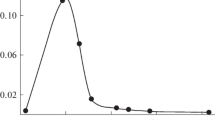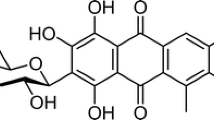Abstract
A method to determine catechin in aqueous solution by measuring chemiluminescence intensities using a stopped flow system has been studied. The lucigenin-hydrogen peroxide chemiluminescence reaction was chosen for the determination of catechin. Fe(II) ion was added to the chemiluminescence system to increase the sensitivity. The chemiluminescence intensity from the lucigenin system was increased by the addition of catechin. Effects of flow rates of reagent and sample and concentrations of lucigenin, hydrogen peroxide, Fe(II) ion and KOH were investigated. The calibration curve for catechin was linear over the range from 1.0×10-3 to 1.0×10-7 M and the detection limit was 3.0×10-7 M under the optimal experimental conditions.
Similar content being viewed by others
References
K. Osada, M. Takahashi, S. Hoshina, M. Nakamura, S. Nakamura, and M. Sugano (2001). Tea catechins inhibit cholesterol oxidation accompanying oxidation of low density lipoprotein in vitro. Comp. Biochem. Phys. C 128, 153–164.
H. Arakawa, M. Kanemitsu, N. Tajima, and M. Maeda (2002). Chemiluminescence assay for catechin based on generation of hydrogen peroxide in basic solution. Anal. Chim. Acta 472, 75–82.
Z. Yaping, Y. Wenli, W. Dapu, L. Xiaofeng, and H. Tianxi (2003). Chemiluminescence determination of free radical scavenging abilities of ‘tea pigments’ and comparison with ‘tea polyphenols.’ Food Chem. 80, 115–118.
Y. J. Kim, J. E. Chung, M. Kurisawa, H. Uyama, and S. Kobayashi (2004). Superoxide anion scavenging and xanthine oxidase inhibition of (+)-catechin–aldehyde polycondensates. Amplification of antioxidant property of (+)-catechin by polycondensation with aldehydes. Biomacromolecules 5, 547–552.
H. Y. Zhang and L. F. Wang (2003). Effects of metal ions distinguishing between one-step hydrogen- and electron-transfer mechanisms for the radical-scavenging reaction of (+)-catechin. J. Phys. Chem. A 107, 11258–11259.
T. Geetha, A. Garg, K. Chopra, and I. P. Kaur (2004). Delineation of antimutagenic activity of catechin, epicatechin and green tea extract. Mutat. Res. 556, 65–74.
H. Lou, H. Yuan, B. Ma, D. Ren, M. Ji, and S. Oka (2004). Polyphenols from peanut skins and their free radical-scavenging effects. Phytochemistry 65, 2391–2399.
N. J. Temple and K. K. Gladwin (2003) Fruit, vegetables, and the prevention of cancer: Research challenges. Nutrition 19, 467–470.
J. R. Cerhan, K. G. Saag, L. A. Merlino, T. R. Mikuls, and L. A. Criswell (2003). Antioxidant micronutrients and risk of rheumatoid arthritis in a cohort of older women. Am. J. Epidemiol. 157, 345–354.
S. Mandel and M. B. H. Youdim (2004). Catechin polyphenols: Neurodegeneration and neuroprotection in neurodegenerative diseases. Free Radical Bio. Med. 37, 304–317.
J. J. Dalluge and B. C. Nelson (2000). Determination of tea catechins. J. Chromatogr. A 881, 411–424.
K. Kondo, M. Kurihara, N. Miyata, T. Suzki, and M. Toyoda (1999). Mechanisitic studies of catechins as antioxidants against radical oxidation. Arch. Biochem. Biophys. 362, 79–86.
M. Pelillo, M. Bonoli, B. Biguzzi, A. Bendini, T. G. Toschi, and G. Lercker (2004). An investigation in the use of HPLC with UV and MS-electrospray detection for the quantification of tea catechins. Food Chem. 87, 465–470.
A. A. García, B. C. Grande, and J. S. Gándara (2004). Development of a rapid method based on solid-phase extraction and liquid chromategraphy with ultraviolet absorbance detection for the determination of polyphenols in alcohol-free beers. J. Chromatogr. A 1054, 175–180.
E. Nishitani and Y. M. Sagesaka (2004). Simultaneous determination of catechins, caffeine and other phenolic compounds in tea using new HPLC method. J. Food Compos. Anal. 17, 675–685.
L. C. Lin, L. C. Hung, and T. H. Tsai (2004). Determination of (-)-epigallocatechin gallate in rat blood by microdialysis coupled with liquid chromatography. J. Chromatogr. A 1032, 125–128.
T. Toyooka, T. Kashiwazaki, and M. Kato (2003). On-line screening methods for antioxidants scavenging superoxide anion radical and hydrogen peroxide by liquid chromatography with indirect chemiluminescence detection. Talanta 60, 467–475.
B. Yang, K. Arai, and F. Kusu (2000). Determination of catechins in human urine subsequent to tea ingestion by high-performance liquid chromatography with electrochemical detection. Anal. Biochem. 283, 77–82.
F. J. Alvarez, N. J. Parekh, B. Matuszewski, R. S. Givens, T. Higuchi, and R. L. Schowen (1986). Multiple intermediates generate fluorophore-derived light in the oxalate/peroxide chemiluminescence system. J. Am. Chem. Soc. 108, 6435–6437.
T. Hasebe and T. Kawashima (1996). Flow injection determination of ascorbic acid by iron(III)-catalyzed lucigenin chemiluminescence in micellar system. Anal. Sci. 12, 773–777.
Author information
Authors and Affiliations
Corresponding author
Rights and permissions
About this article
Cite this article
Lee, J.M., Karim, M.M. & Lee, S.H. Determination of Catechin in Aqueous Solution by Chemiluminescence Method. J Fluoresc 15, 735–739 (2005). https://doi.org/10.1007/s10895-005-2981-9
Received:
Accepted:
Issue Date:
DOI: https://doi.org/10.1007/s10895-005-2981-9




